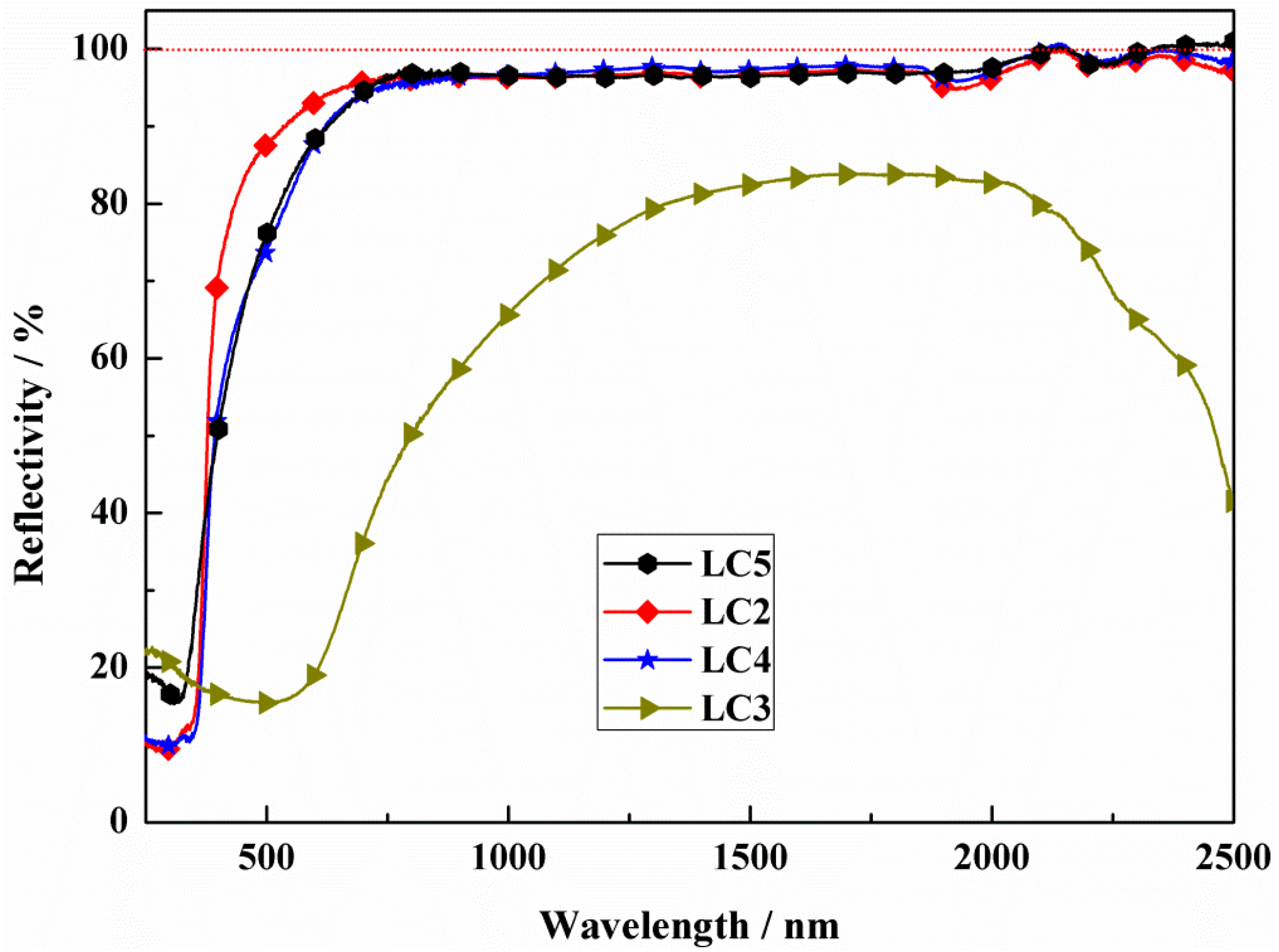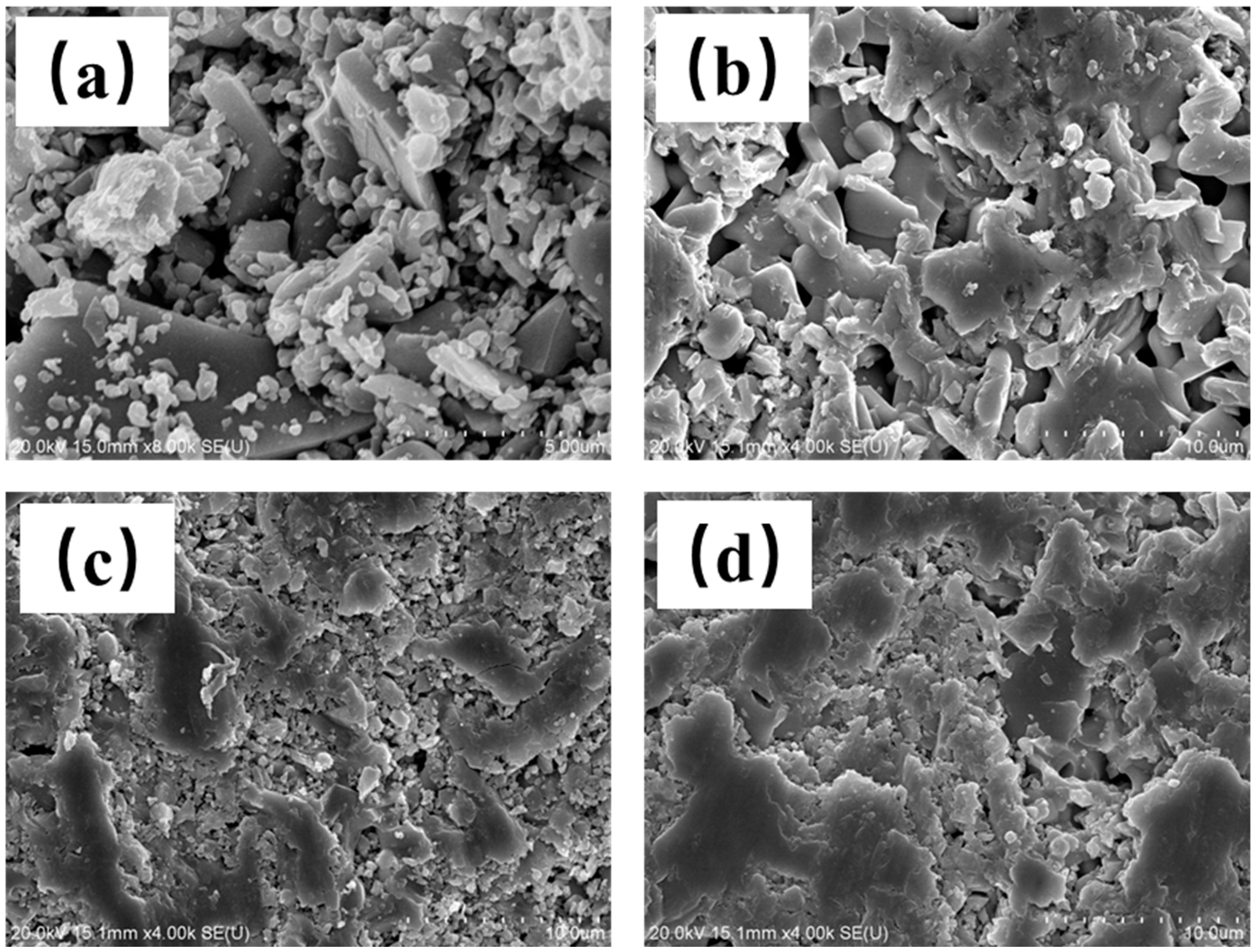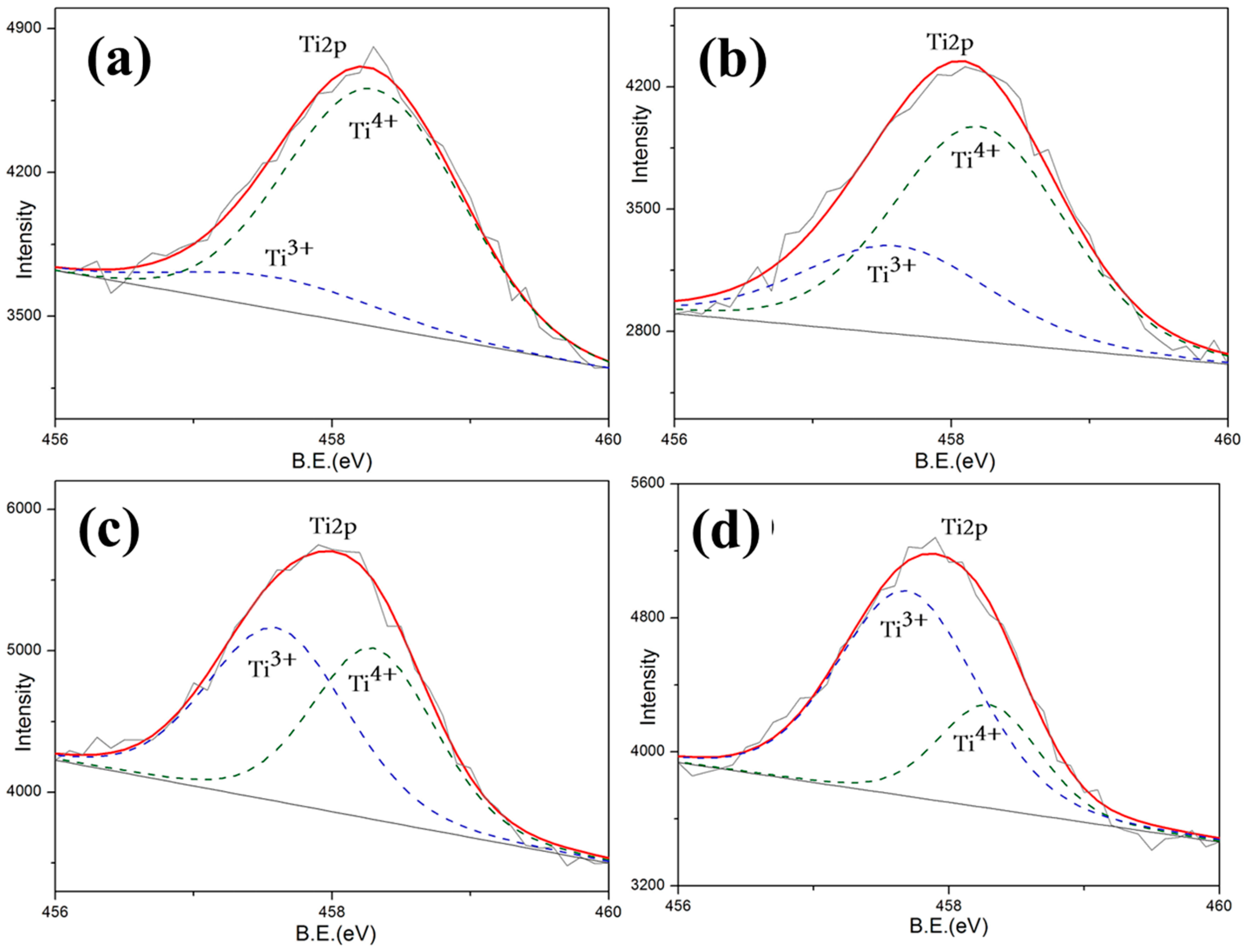Influence of Oxygen-Release Material Doping on the Optical Properties of La1–xSrxTiO3+δ
Abstract
1. Introduction
2. Materials and Methods
2.1. Sample Preparation
2.2. Characterization
3. Results and Discussion
3.1. Surface Morphology and Optical Analysis of Different CeO2 Content-Doped LST-CO
3.2. Surface Morphology and Optical Property Analysis of Different-Temperature-Sintered LST-CO
3.3. Phase and XPS Analysis of Different-Temperature-Sintered LST-CO
4. Conclusions
Author Contributions
Funding
Institutional Review Board Statement
Informed Consent Statement
Data Availability Statement
Conflicts of Interest
References
- Li, W.; Ma, Z.; Gao, L.; Wang, F. Preparation and electrical properties of La0.9Sr0.1TiO3+δ. Materials 2015, 8, 1176–1186. [Google Scholar] [CrossRef] [PubMed]
- Vilquin, B.; Kanki, T.; Yanagida, T.; Tanaka, H.; Kawai, T. Effect of Sr doping on LaTiO3 thin films. Appl. Surf. Sci. 2005, 244, 494–497. [Google Scholar] [CrossRef]
- Higuchi, T.; Tsukamoto, T.; Taguchi, Y.; Tokura, Y.; Shin, S. Electronic structure for the metal-insulator transition in La1-xSrxTiO3 probed by resonant soft-X-ray emission spectroscopy. Phys. B Condens. Matter 2004, 351, 310–312. [Google Scholar] [CrossRef]
- Yun, J.N.; Zhang, Z.Y.; Yan, J.F.; Wu, Z. Electronic structure and optical properties of La-doped SrTiO3 and Sr2TiO4 by density function theory. Chin. Phys. Lett. 2009, 26, 017107. [Google Scholar]
- Turky, A.O.; Rashad, M.M.; Hassan, A.M.; Elnaggar, E.M.; Bechelany, M. Optical, electrical and magnetic properties of lanthanum strontium manganite La1-xSrxMnO3 synthesized through the citrate combustion method. Phys. Chem. Chem. Phys. 2017, 2, 9. [Google Scholar] [CrossRef] [PubMed]
- Zhu, J.; Gao, L.; Ma, Z.; Liu, Y.; Wang, F. Optical property of La1-xSrxTiO3+δ coatings deposited by plasma spraying technique. Appl. Surf. Sci. 2015, 356, 935–940. [Google Scholar] [CrossRef]
- Tului, M.; Arezzo, F.; Pawlowski, L. Optical Properties of Plasma Sprayed ZnO + Al2O3 Coatings. Surf. Coat. Technol. 2004, 179, 47–55. [Google Scholar] [CrossRef]
- Gao, L.; Ma, Z.; Wang, S.; Wang, F.; Yang, C. Structural and optical properties of La1-xSrxTiO3+δ. Materials 2014, 7, 4982–4993. [Google Scholar] [CrossRef]
- Seok, H.K.; Choi, E.Y.; Cha, P.R.; Son, M.C.; Choi, B.L. Characterization of Plasma-Sprayed Y2O3 Coating and Investigation of Its Visual Aspect Change. Surf. Coat. Technol. 2011, 205, 3341–3346. [Google Scholar] [CrossRef]
- Ma, R.; Li, Z.; Liu, F. The effect of Gd3+ and Ti4+ co-doping on the thermal radiation performance of (Sm1-xGdx)2(Hf1-xTix)2O7 (0 ≤ x ≤ 0.2) ceramic coatings. Cerammic Int. 2019, 45, 16130–16137. [Google Scholar] [CrossRef]
- Sutton, R.J.; Eperon, G.E.; Miranda, L.; Parrott, E.S.; Kamino, B.A.; Patel, J.B.; Hörantner, M.T.; Johnston, M.B.; Haghighirad, A.A.; Moore, D.T.; et al. Bandgaptunable cesium lead halide perovskites with high thermal stability for efficient solar cells. Adv. Energy Mater. 2016, 6, 1502458. [Google Scholar] [CrossRef]
- Xiao, Y.; Jia, W.; Du, M.; Li, Z.; Ma, Y.; Zou, Y.; Ma, C.; Yi, X.; Wang, J.; Li, Y.; et al. High-entropy (YxEr1-x)2(Ti0.2Zr0.2Hf0.2Ge0.2Sn0.2)2O7 oxide: A promising thermal barrier coating material with potential fluorescent Nondestructive Function. Mater. Sci. Eng. B 2025, 316, 118145. [Google Scholar] [CrossRef]
- Pawlowski, L. The Science and Engineering of Thermal Spray Coatings; Wiley: Chichester, UK, 1995; Chapter 8; pp. 484–501. [Google Scholar]
- Zhu, J.; Ma, Z.; Gao, Y.; Gao, L.; Pervak, V.; Wang, L.; Wei, C.; Wang, F. Ablation behavior of plasma-sprayed La1-xSrxTiO3+δ coating irradiated by high-intensity continuous laser. ACS Appl. Mater. Interfaces 2017, 9, 35444–35452. [Google Scholar] [CrossRef]
- Kumar, P.; Jena, P.; Patro, P.K.; Lenka, R.K.; Sinha, A.S.K.; Singh, P.; Singh, R.K. Influence of Lanthanum Doping on Structural and Electrical/Electrochemical Properties of Double Perovskite Sr2CoMoO6 as Anode Materials for Intermediate-Temperature Solid Oxide Fuel Cells. ACS Appl. Mater. Interface 2022, 8, 24659–24667. [Google Scholar] [CrossRef] [PubMed]
- Jaffari, G.H.; Imrana, A.; Bah, M.; Ali, A.; Bhatti, A.S.; Qurashi, U.S.; Shah, S.I. Identification and quantification of oxygen vacancies in CeO2 nanocrystals and their role in formation of F-centers. Appl. Surf. Sci. 2017, 396, 547–553. [Google Scholar] [CrossRef]
- Atran, A.A.; Algethami, J.S.; Hegazy, H.; Hamdy, M.S. Improving the photoluminescence of CeO2 nanoparticles via creating oxygen vacancies in the crystal lattice. Optik 2024, 308, 171818. [Google Scholar] [CrossRef]
- Su, X.H.; Li, W.J.; Chen, D.; Zhang, S.; Lou, C.G.; Tian, Q.; Zhao, J.G.; Zhao, P. Rapid fabrication of oxygen-deficient zirconia by flash sintering treatment. J. Adv. Ceramics. 2024, 13, 1881–1890. [Google Scholar] [CrossRef]
- Yang, J.; Tan, L.; Ji, P.; Sun, F.; Tian, Q.; Su, X. Rapid preparation of Gd2Zr2-xCexO7 waste forms by flash sintering and their chemical durability. J. Eur. Ceram. Soc. 2023, 43, 4950–4957. [Google Scholar] [CrossRef]
- Bandna, B.; Santosh, K.; Lee, H.N.; Rajesh, K. Formation of Oxygen Vacancies and Ti3+ State in TiO2 Thin Film and Enhanced Optical Properties by Air Plasma Treatment. Sci. Rep. 2016, 6, 32355. [Google Scholar]
- Biswas, A.; Li, N.; Jung, M.H.; Lee, Y.W.; Kim, J.S.; Jeong, Y.H. La Doped SrTiO3 Thin Films on SrLaAIO4(001) as Transparent Conductor. J. Appl. Phys. 2013, 113, 183711. [Google Scholar] [CrossRef]
- Chen, L.; Wang, J.H.; Huang, C.P.; Zhang, Q.; Chang, C.; Chang, A.; Yao, J. High performance of Ni0.9Mn1.8Mg0.3O4 spinel nanoceramic microbeads via inkjet printing and two step sintering. RSC Adv. 2016, 6, 35118–35123. [Google Scholar] [CrossRef]
- Stokes, R.J. Correlation of mechanical properties with microstructure. Natl. Bur. Stand. Misc. Publ. 1964, 257, 41–72. [Google Scholar]
- Meng, F.; Fan, Z.; Zhang, C.; Hu, Y.; Guan, T.; Li, A. Morphology-controlled synthesis of CeO2 microstructures and their room temperature ferromagnetism. J. Mater. Sci. Technol. 2017, 33, 444–451. [Google Scholar] [CrossRef]
- Wang, L.; Li, Y.; Liu, J.; Tian, Z.; Jing, Y. Regulation of oxygen vacancies in cobalt-cerium oxide catalyst for boosting decontamination of VOCs by catalytic oxidation. Sep. Purif. Technol. 2021, 277, 119505. [Google Scholar] [CrossRef]
- Shi, J.; Li, H.; Genest, A.; Zhao, W.; Qi, P.; Wang, T.; Rupprechter, G. High-performance water gas shift induced by asymmetric oxygen vacancies: Gold clusters supported by ceria-praseodymia mixed oxides. Appl. Catal. B Environ. 2022, 301, 120789. [Google Scholar] [CrossRef]
- Smirnova, I.; Bazhenov, A.; Fursova, T.; Dubovitskii, A.; Uspenskaya, L.; Maksimuk, M. IR-Active Optical Phonons in Pnma-1, Pnma-2 and R3c Phases of LaMnO3+δ. Phys. B 2008, 403, 3896–3902. [Google Scholar] [CrossRef]
- Zhao, Y.; Zhu, J.; Wang, H.; Ma, Z.; Gao, L.H.; Liu, Y.B.; Liu, Y.; Shu, Y.C.; He, J. Enhanced optical reflectivity and electrical properties in perovskite functional ceramics by inhibiting oxygen vacancy formation. Ceram. Int. 2021, 47, 5549–5558. [Google Scholar] [CrossRef]









| Sample | Temperature/°C | LST/wt.% | CeO2/wt.% |
|---|---|---|---|
| LC0 | 1450 | 100 | 0 |
| LC1 | 1450 | 90 | 10 |
| LC2 | 1450 | 80 | 20 |
| LC3 | 1550 | The appropriate proportion of LST and CeO2 | |
| LC4 | 1300 | ||
| LC5 | 1200 | ||
| Sample (Sintering Temperature °C) | Ti4+/% | Ti3+/% | Ce4+/% | Ce3+/% | Total of Ti4+ and Ce4+ |
|---|---|---|---|---|---|
| LC5 (1200) | 86.6 | 13.4 | 63.8 | 36.2 | 150.4 |
| LC4 (1300) | 73.3 | 26.7 | 63.3 | 36.7 | 136.6 |
| LC1 (1450) | 68.8 | 31.2 | 61.6 | 38.4 | 130.4 |
| LC3 (1550) | 26.8 | 73.2 | 46.9 | 53.1 | 73.7 |
| Doping Content/wt.% | 0 | 10 | 20 | |
|---|---|---|---|---|
| Temperature/°C | ||||
| 1200 | - | 97 | - | |
| 1300 | - | 96 | - | |
| 1450 | 92 | 96 | 83 | |
| 1550 | - | 66 | - | |
Disclaimer/Publisher’s Note: The statements, opinions and data contained in all publications are solely those of the individual author(s) and contributor(s) and not of MDPI and/or the editor(s). MDPI and/or the editor(s) disclaim responsibility for any injury to people or property resulting from any ideas, methods, instructions or products referred to in the content. |
© 2025 by the authors. Licensee MDPI, Basel, Switzerland. This article is an open access article distributed under the terms and conditions of the Creative Commons Attribution (CC BY) license (https://creativecommons.org/licenses/by/4.0/).
Share and Cite
Li, W.; Zhu, Y.; He, Z. Influence of Oxygen-Release Material Doping on the Optical Properties of La1–xSrxTiO3+δ. Materials 2025, 18, 2553. https://doi.org/10.3390/ma18112553
Li W, Zhu Y, He Z. Influence of Oxygen-Release Material Doping on the Optical Properties of La1–xSrxTiO3+δ. Materials. 2025; 18(11):2553. https://doi.org/10.3390/ma18112553
Chicago/Turabian StyleLi, Wenzhi, Yichao Zhu, and Zhiping He. 2025. "Influence of Oxygen-Release Material Doping on the Optical Properties of La1–xSrxTiO3+δ" Materials 18, no. 11: 2553. https://doi.org/10.3390/ma18112553
APA StyleLi, W., Zhu, Y., & He, Z. (2025). Influence of Oxygen-Release Material Doping on the Optical Properties of La1–xSrxTiO3+δ. Materials, 18(11), 2553. https://doi.org/10.3390/ma18112553





